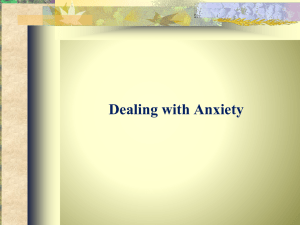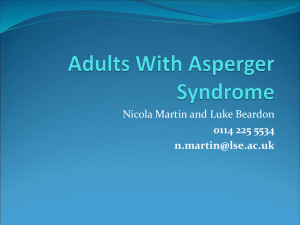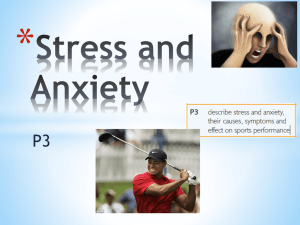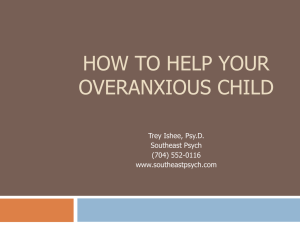Moving Towards Emotional Maturity in Helping Relationships
advertisement
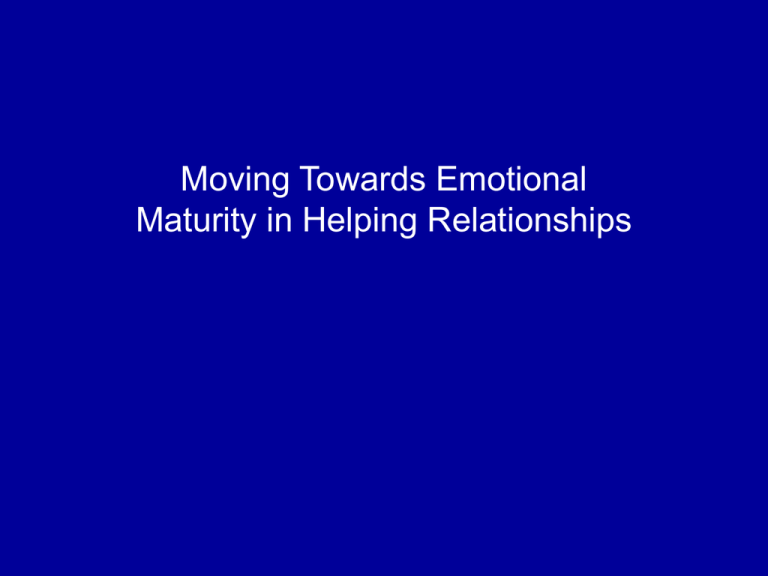
Moving Towards Emotional Maturity in Helping Relationships What Are the Three Most important Resources you Bring to a Helping Relationship? • Yourself • Yourself • Yourself • Bringing the best possible “Self” to the relationship is not self-ish. It is responsible, healthy, and generous. What is Stress/Anxiety ? • The body’s response to a threat, or a disruption to the homeostatic balance of the organism. – Includes automatic physiological adaptations to the threatening environment. – There are physical and psychological changes– (heart, immune system, sleep, learning, memory, etc.) Chronic Stress/ Anxiety • Why Zebra’s Don’t Get Ulcers, Robert Sapolsky, professor of neurology and nerurosurgery at Sanford University. • Zebras react only to acute stress • Humans turn on the same stress response for perceived or imagine threats. • Humans have a hard time turning off their stress response system. “For the most part, only humans can keep the HPA axis going indefinitely. We can do this because of how our faculties of perception, thought, and emotion are produced in the brain and how they are connected to the stress response.” (McEwen) Chronic stress leads to Symptoms • The Balance Within: The Science Connecting Health and Emotions, Esther Sternberg, M.D. , NIMH, NIH – Physical Sx – Emotional Sx – Social Sx So. . . . Anxiety/Stress (threats, real or perceived and our response to them) will impair our ability to be a resource for others. Anxiety/ Stress is a significant contributor to the challenges others face. What intensifies Stress? California sea snail From Metapsychology to Molecular Biology:Explorations Into the Nature of Anxiety Eric R. Kandel - American Journal of Psychiatry 140:1277-1293, 1983 Train one group of animals with warning cue, then a head shock; train other group without warning. Measure escape locomotion of each group. California sea snail From Metapsychology to Molecular Biology:Explorations Into the Nature of Anxiety Eric R. Kandel - American Journal of Psychiatry 140:1277-1293, 1983 Train one group of animals with warning cue, then a head shock; train other group without warning. Measure escape locomotion of each group. Assay degree of learned anxiety by measuring the amount of escape locomotion an animal displays following training: California sea snail From Metapsychology to Molecular Biology:Explorations Into the Nature of Anxiety Eric R. Kandel - American Journal of Psychiatry 140:1277-1293, 1983 Train one group of animals with warning cue, then a head shock; train other group without warning. Measure escape locomotion of each group. Assay degree of learned anxiety by measuring the amount of escape locomotion an animal displays following training: Animals trained with warning stimulus showed no California sea snail increase in escape locomotion when tested in absence of warning; when signal present, however, group exhibited significantly more escape locomotion than when signal not present. This means the animals had no apprehension in the absence of a cue (anticipatory). From Metapsychology to Molecular Biology:Explorations Into the Nature of Anxiety Eric R. Kandel - American Journal of Psychiatry 140:1277-1293, 1983 Train one group of animals with warning cue, then a head shock; train other group without warning. Measure escape locomotion of each group. Assay degree of learned anxiety by measuring the amount of escape locomotion an animal displays following training: Animals trained with warning stimulus showed no California sea snail increase in escape locomotion when tested in absence of warning; when signal present, however, group exhibited significantly more escape locomotion than when signal not present. This means the animals had no apprehension in the absence of a cue (anticipatory). Animals trained without warning cue, show a generally heightened responsiveness that is unaffected by presence or absence of a warning cue (chronic anxiety). From Metapsychology to Molecular Biology:Explorations Into the Nature of Anxiety Eric R. Kandel - American Journal of Psychiatry 140:1277-1293, 1983 One Example of intensification of stress response: -- Unpredictable --Uncontrollable California sea snail In helping relationships we are confronted with the constant stress of dealing with situations that we (as helpers) can’t control and can’t predict. From Metapsychology to Molecular Biology:Explorations Into the Nature of Anxiety Eric R. Kandel - American Journal of Psychiatry 140:1277-1293, 1983 What Do we Do? • Fight, Flight, Freeze, Care-take • Automatic, instinctive, pre-cognitive reactions– reduce the stress!! • Conflict • Distance/Cut off • Over/Under Function • Triangle • None of these are long term solutions for toning down the stress/anxiety. What Does Work to Reduce Stress/ Anxiety? • Becoming more of a “Self”--- Developing emotional maturity. Definitions of Emotional Maturity • The ability to be responsible for my own thinking, feeling, and acting while allowing others to do the same. • Be in contact with highly anxious people/situations without taking on the stress for yourself • Clear about the difference between thinking and feeling, know which one you are doing, and free to choose between them. Levels of Emotional Maturity Low levels: feeling-dominated. No distinction between feeling & fact. Energy into seeking love & approval, and little available for life goals. Intellectual functioning submerged. (Minimal self-regulation.) Low levels: feeling-dominated. No distinction between feeling & fact. Energy into seeking love & approval, and little available for life goals. Intellectual functioning submerged. (Minimal self-regulation.) Moderate levels: Beginning differentiation of emotional &intellectual systems, with most of the self expressed as pseudo self. When anxiety is low, functioning can resemble higher levels. Low levels: feeling-dominated. No distinction between feeling & fact. Energy into seeking love & approval, and little available for life goals. Intellectual functioning submerged. (Minimal self-regulation.) Moderate levels: Beginning differentiation of emotional &intellectual systems, with most of the self expressed as pseudo self. When anxiety is low, functioning can resemble higher levels. Moderate to good levels: Enough differentiation between intellectual & emotional systems to function as a cooperative team. Functional intellectual system. (High self-regulation) • Levels of Emotional Maturity relate to how much “self” exists in relationships. A conceptual continuum of Self No-self: Cannot differentiate between feeling and intellectual systems. A dysfunctional intellectual system. Only capable of a narcissistic “I”, such as “I want–I’m hurt-I have the right.” Others exist to meet my wants and needs. I exist to meet the needs or wants of others. Pseudo-self is made up of knowledge incorporated by the intellect and of principles and beliefs acquired from others. It is acquired from others, and it is negotiable in relationship with others. It can be changed by emotional pressure to enhance one’s image with others or to oppose the other. In the average person, the level of solid self is fairly low in comparison with the level of pseudo-self. A pseudo-self can function well in most relationships; but in an intense emotional relationship, such as marriage, the pseudo-self of one merges with the pseudo-self of the other. One becomes the functional self and the other a functional no-self. Solid self is a manifestation of a functional intellectual system that withstands pressure from the feeling system. It is made up of firmly held convictions and beliefs that are formed slowly and can be changed from within self, are never changed by coercion or persuasion by others. (“I believe-I will do-I will not do.”) Compassion malignant compassion no-self solid self malignant indifference no-self Compassion malignant compassion no-self anxiety-driven solid self malignant indifference no-self anxiety-driven Compassion malignant compassion no-self solid self malignant indifference no-self A person in this mid-range has enough solid self to experience compassion for others without feeling compelled to launch into an overfunctioning mode. Ie. Doing for others what they can our should do for self. How Emotional Maturity Develops • Develop clear values, goals, beliefs, principles for the situation or relationship. • Define your self by your actions—what you will or won’t do– without needing to convince or persuade others. • Stay in contact with stress-producing people/situations. • Observe your self. Benefits • Healthier, stronger You. • When an anxious mind comes into contact with a less anxious mind, the anxious mind calms down and has better access to thinking. Relationship Dilemma and Symptom Development Coping Mechanisms: distancing to insulate from emotional intensity seeing the problem as in the other emotional wellbeing derived from doing for the other Failure in Adaptation: reciprocal process blocked from sustaining emotional connection seeing cause of problem as in oneself feeling isolated and out-of-control




